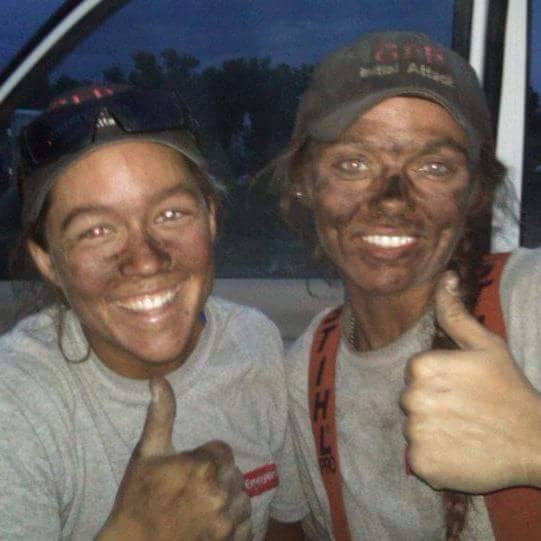This post is part of a series that is a companion to the feature article in Your National Forests Summer/Fall 2017. Get to know the women featured in the article a bit more through this series.
Lacey England flew in a helicopter nine times before she ever had to make a landing in one. That’s because those first eight flights she took, she got her feet back on land by rappelling to the ground, first in rookie training, then as a certified member of the Gallatin Rappel Crew, based on Montana’s Custer-Gallatin National Forest.
Lacey grew up in central Washington and her family frequently took trips to nearby National Forests. Wildland firefighting wasn’t on her radar screen, but she had always been interested in nature and work that took her outside (at one point Lacey owned and operated a tree service in Oregon). She was intrigued when a good friend told her about his firefighting experience with a private contractor. “He told me that it was a perfect fit for me, and from what he told me about his experience, it sounded like he was right.” She was majoring in Natural Resources Sciences at Washington State University at the time and decided to give it a try during a summer break.
Lacey spent three seasons with the private contractor before hearing about the Forest Service rappel program during a fire assignment in Montana. While private contract work was flexible, she was looking for something different. She had given some thought to smokejumping, but wasn’t certain. Rappelling sounded like it might be a better fit. She applied and was accepted to the Gallatin Rappel Crew, based in Bozeman, Montana. “I had no expectations though, I really had no idea what I was getting into. But it all worked out,” she laughs.
Lacey is in her fifth rappel season this year, and it is her first with a permanent appointment, which guarantees her work for 13 pay periods. A permanent position also provides employees with the potential for lateral moves, and opportunities for applying for advancement that might only be advertised to internal candidates. “I’m not sure how long I will stay with this crew, or in fire, but having a permanent appointment opens doors.”
She has started training to be a helicopter manager and incident commander for certain levels of fires. Next, in a couple of years, she is planning to begin spotter training, which is a step-up in responsibility. Once a rappel crew is dispatched to a fire, the spotter has the primary responsibility for doing rappel crew member safety checks, communicating with the pilot, determining the best site to rappel into, and leading the process to get crew members and then gear bags safely to the ground.
Lacey’s first fire rappel was on the Nez Perce-Clearwater National Forest. But the summer of 2013 was one of her most memorable fire seasons. “It was rappelapoolooza,” she recalls about the number of fires her crew was being sent out on. “During one stretch we were working out of Grangeville, Idaho and I went on four back-to-back fires. I’d get off a fire, get transported back to the heli-base, and just have enough time to get my belly-bag repacked, maybe an hour, before we were sent off again. It was a meat grinder – but it was great - those tough experiences are the ones that seem to stand out since you pushed through and survived it.”
Lacey has never worked on a crew with more than one other female, and sometimes has worked a fire season as the only woman on the crew. But Lacey does see some positive actions taking place to support women in navigating the world of wildland firefighting. Last year Lacey attended an interagency training event on prescribed burning that accepted 90 percent women and 10 percent men, to provide a role reversal of the current gender ratio in wildland fire.
"I’d get off a fire, get transported back to the heli-base, and just have enough time to get my belly-bag repacked, maybe an hour, before we were sent off again."
“It was an amazing experience, and along with developing burn plans and learning about fire as a prescriptive treatment, we had extremely productive conversations about women in fire. I met some great role models. And the men that attended really had their eyes opened when they heard the similarities in the stories that we were sharing – it made an impact for them to hear that these aren’t just isolated incidents that happen to one or two of us, that it is really pervasive.”
Lacey’s advice to other women who are interested in working as a wildland firefighter is to have a good support system, and to have a realistic expectation that you are going to encounter some type of sexism. “You have to go into it recognizing that it is a male-dominated culture. You have to prepare yourself for that and make a plan for how you are going to deal with it. The plan has to be one that works for you; we are all going to react differently and have our own lines that we draw in the sand. But you shouldn’t ever allow inappropriateness to be normalized. And you shouldn’t be intimidated.”

Lacey also bristles a bit when the phrase, “women in fire” gets used as a blanket description. “Women firefighters shouldn’t all be defined in the same way. We don’t all fit the same mold.” She’s right. Many firefighters, regardless of gender, wouldn’t be brave enough to fly in a helicopter with the doors open, and then step out of it when it is still 250 feet in the air.
Learn more about Lacey and the world about wildland firefighting in the feature article, "Drawn to Flame: Women Forged by WildFire" in the Summer/Fall 2017 issue of Your National Forests.

